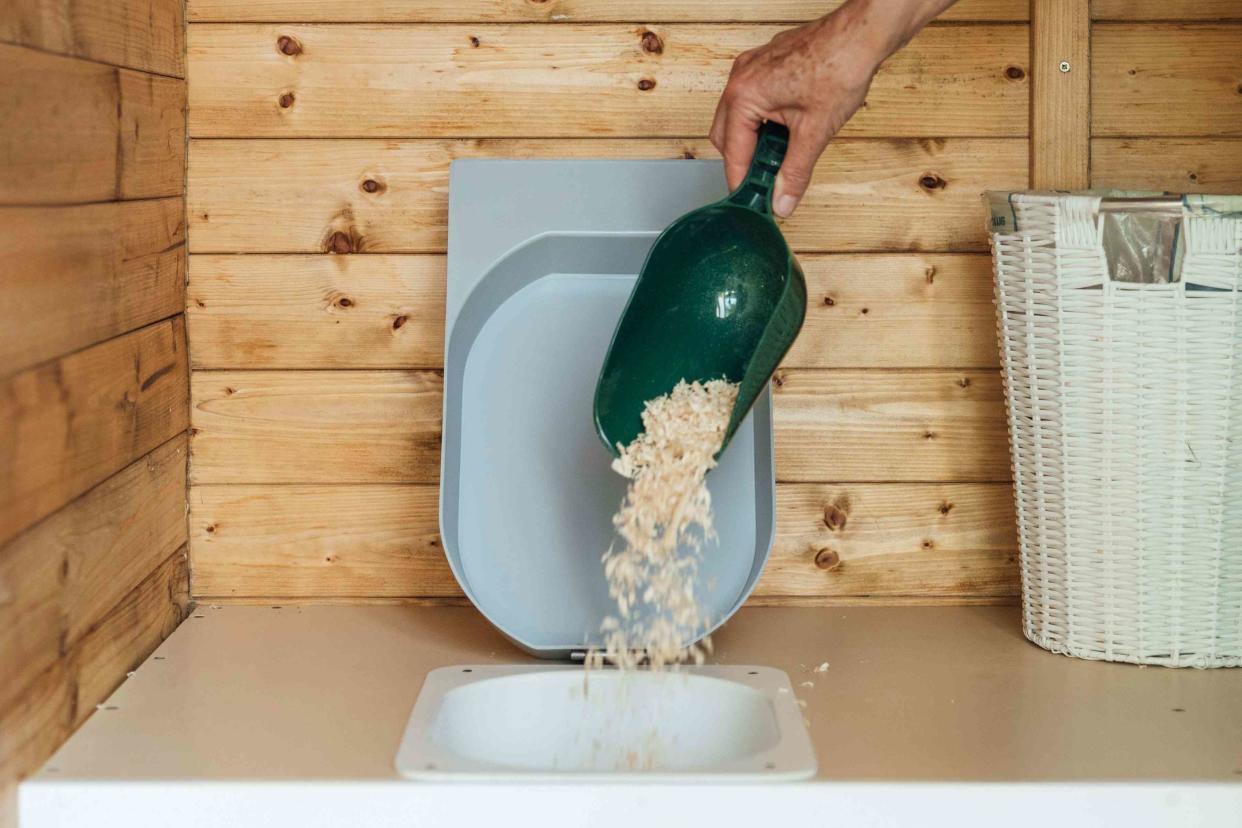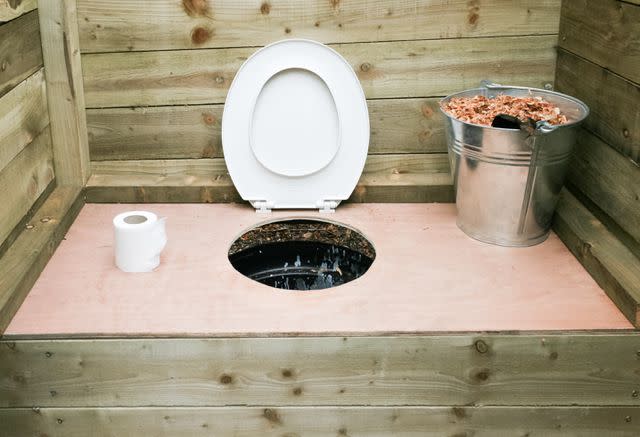What Is a Composting Toilet, and Do You Need One?

SolStock / Getty Images
Composting toilets are gaining in popularity, especially among eco-conscious consumers. Similar to the process of composting food scraps, composting toilets transform human waste into compost-like material that can then be used as fertilizer (if local laws allow it) to enrich soil and support plant growth.
Most composting toilets don't use any water at all, meaning they don't need to be connected to a wastewater system or septic tank. Some are portable, making them ideal for use in RVs, boats, campers, and other temporary living situations. Others are more permanent, meant to last for years, and be used in place of your traditional toilet.
Here's what you should know and consider before buying a composting toilet.
How Do Composting Toilets Work?
Composting toilets use a process known as aerobic decomposition—when organic materials decompose in the presence of oxygen—to break down human waste instead of flushing it down the sewer pipe. There are no chemicals or water involved.
When you "flush" a composting toilet, a trapdoor opens and drops the waste into a chamber. Some composting toilet models have two chambers: one for solids and one for liquids.
After using a composting toilet, you will need to add a carbon-rich material such as sawdust, peat moss, or coconut coir to the chamber. This will help reduce odor and create space for oxygen to get to the waste to break it down.
Handling the Nitty-Gritty Details
Here are a few specifics of how a composting toilet works with urine, feces, and more.
Separating urine and feces: Urine and feces include many chemicals that react when combined, resulting in foul odors. Separating waste substantially reduces odors. That's why composting toilets have a solids bucket or chamber for feces and a urine diverter specifically for liquids.
How long does it take for feces to decompose: Feces do not decompose inside the toilet's chamber. Feces decompose over months outside the toilet in a compost pile.
What happens to diarrhea and vomit: Diarrhea and vomit contain more liquid but it will likely fall to the solids bucket or chamber. Simply clean the toilet out more frequently and keep the exhaust fan running.
What happens to toilet paper: Toilet paper can be used in this type of toilet but it is slow to decompose. It's best to use marine or RV toilet paper which is made to decompose faster but it's also thinner and less comfortable. Some people forgo toilet paper and instead use reusable toilet paper made from washable fabric scraps (like the concept of cloth diapers).
What stops the smell of urine and feces: Several things can stop the smell of waste and it depends on the model of the toilet. These methods include an exhaust fan system that runs frequently or continuously, a urine separator that contains the liquid, and/or a layer of sawdust (or other material) that traps smelly gases.
Where to put urine and feces when cleaning a composting toilet: Most people put feces and urine in a composting pile. Or, the feces that collects in the bowl's bag or removable chamber can go into a heavy-duty trash bag and the urine into a "soaking pit" or a nearby gray water drain.

Types of Composting Toilets
You'll generally find two types of composting toilets: split systems and self-contained systems. The one you choose will depend on the bathroom space and budget you're working with.
Split System
Sometimes called central systems, these composting toilets look similar to traditional toilets that hook up to a septic tank. They are split into two sections: a pedestal (above the floor) and a compost tank (below the floor) connected by a waste chute.
Split systems usually have a larger capacity and are installed in high-traffic areas, making them great for homes, parks, or clubhouses. They are generally more expensive than self-contained composting toilets.
Self-Contained System
These all-in-one models have both the pedestal and the composting container in the same unit. Self-contained composting toilets are popular in tiny houses, cabins, RVs, motorhomes, boats, and single-level homes built on a concrete slab.
What to Consider Before Purchasing a Composting Toilet
If you're looking to be more sustainable at home, a composting toilet may be for you. But before you swap your traditional toilet for a composting toilet, consider these factors. The model you purchase will depend on your situation, needs, and budget.
Capacity
Composting toilets need to be emptied, and how often you have to do so will depend on its capacity. The larger the unit, the longer you can go between emptying.
Regular emptying of your composting toilet is important to keep it clean and functioning properly. In general, if your composting toilet is used regularly at your residence, you will want to remove the compost at least once a month. If your composting toilet is used occasionally—such as on RV road trips—then the compost can be emptied once a season.
Cleaning
You can't use harsh chemicals to clean a composting toilet. Commercial toilet cleaners and cleaning wipes are designed to kill bacteria—including the good bacteria necessary for composting. Instead, use a homemade toilet cleaner containing vinegar or liquid citric acid, which will effectively clean without disrupting the composting environment.
When choosing a composting toilet, consider how easy it will be to clean, as some are easier to wipe down and empty than others.
Smell
Odor is one of the top concerns people have with composting toilets. However, a properly maintained composting toilet should not smell. If it does, that indicates something is wrong.
There are a few main reasons why a composting toilet may emit an odor:
The solids chamber may be too wet; the urine diverter may not work correctly.
There's too much humidity in the air and the chamber requires more covering material.
The ventilation/exhaust fan stopped working.
Harsh chemicals were used to clean the toilet but in the process killed composting bacteria.
Toilet paper or wipes negatively affected the covering material in the chamber; put toilet paper in a separate disposal container to reduce odors.
When used and cared for properly, a composting toilet will not smell.
Frequently Asked Questions
How do you empty a composting toilet?
How you empty your composting toilet will depend on its specific design. If the chamber of your composting toilet is lined with a biodegradable bag, simply remove and tie the bag with a knot. If the chamber is not lined, take it out and empty the contents directly into a compost pile.
You can add the contents of your composting toilet to an existing compost pile or use it as fertilizer over lawns and non-edible gardens. If you don't want to use it as fertilizer, you can also dispose of the waste in a trash receptacle.
What are the drawbacks of a composting toilet?
Composting toilets require more upkeep and maintenance than standard toilets to work properly. Poorly maintained composting toilet systems can lead to odors and health hazards. They also require you to manually remove the end product, rather than just being able to flush human waste down the drain.
Do you need to empty a composting toilet?
Yes, you have to empty a composting toilet when it gets full since it can't be flushed into the sewer or septic systems like traditional toilets.
Read Next: The 6 Best Composting Toilets of 2024
Read the original article on The Spruce.

